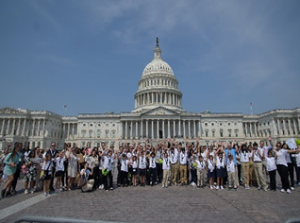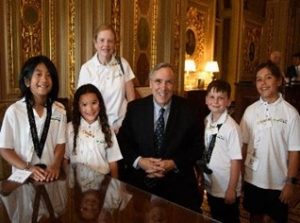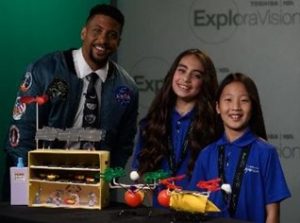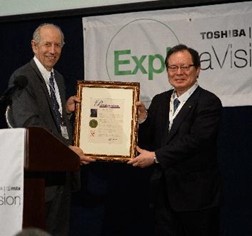Meet the Next-Generation of Leaders: The 2025 ExploraVision STEM Competition National Winners
In June, Toshiba and NSTA honored the national winners of the 33rd annual ExploraVision program in Washington, D.C. The winning teams presented their projects and celebrated their recognition as the finalists of the world’s largest K-12 STEM competition.
The ExploraVision competition, which has garnered participation from nearly 450,000 students across the U.S. and Canada since its creation, helps to empower the next generation of STEM leaders.
Throughout the process, K-12 students work within their teams to identify how innovative technologies can be used to create solutions to address real world problems. ExploraVision challenges students to not only think critically by looking at the world around them more deeply but also encourages them to build foundational skills like collaboration.
This year, nearly 3,000 teams created projects for ExploraVision. The eight teams selected as national winners traveled to D.C. where they showcased their projects to an esteemed panel of experts including executives from Toshiba and NSTA, government officials, Bill Nye the Science Guy and President of the Planetary Society, and Justin “Mr. Fascinate” Shaifer
The 2025 National Winners:
First-Place Winners:
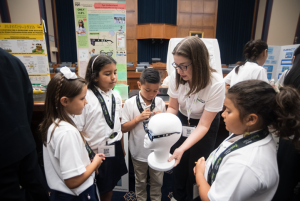 Created by 2nd graders Jael Zeeb, Erandi Horn-Gomez, Mia Rodriguez, and Rebecca Brandt from A.D. Henderson University School in Boca Raton, Florida. Supported by Coach Jennifer O’Sullivan.
Created by 2nd graders Jael Zeeb, Erandi Horn-Gomez, Mia Rodriguez, and Rebecca Brandt from A.D. Henderson University School in Boca Raton, Florida. Supported by Coach Jennifer O’Sullivan.
Only 2.8% of people in the U.S. know sign language, making communication difficult for many deaf individuals. This team developed smart glasses that translate sign language into speech. The built-in camera records hand gestures, sends the video to an app for translation, and the glasses speak the words aloud. The goal of this innovative solution is to make communication more accessible for all.
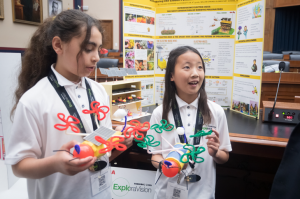 Created by 4th graders Luciana Nishanian and Scarlett Lin from Willow Springs Elementary School in Fairfax, Virginia. Supported by Coach Logan Williams and Mentor Nunik Nishanian.
Created by 4th graders Luciana Nishanian and Scarlett Lin from Willow Springs Elementary School in Fairfax, Virginia. Supported by Coach Logan Williams and Mentor Nunik Nishanian.
Electro-BUZZ is a smart technology that uses special drones to pollinate plants, just like bees! With bees struggling and more people needing food, these drones step in to help. Powered by clean energy like solar, wind, and kinetic, they work together to cover large areas and keep crops growing. The Smart Hive tracks pollination and supports the environment. Strong, energy-efficient, and eco-friendly, Electro-BUZZ combines nature and technology to protect our planet and ensure a healthy future for food and farming!
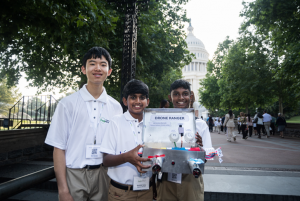 Created by 7th graders Aarnavi Ghorai, Kyle Li, Srinithik Sabry from Twin Groves Middle School in Buffalo Grove, Illinois. Supported by Coach Nicole McRee.
Created by 7th graders Aarnavi Ghorai, Kyle Li, Srinithik Sabry from Twin Groves Middle School in Buffalo Grove, Illinois. Supported by Coach Nicole McRee.
The Drone Ranger (DR) represents a cutting-edge innovation in wildfire mitigation, combining advanced technologies to address the challenges posed by increasingly frequent and destructive wildfires. DR is a thermoelectricity and hydrogen powered drone made of stainless steel with tantalum hafnium carbide coating for unparalleled heat resistance. DR has a unique AI-trained camera network to monitor forest conditions and fires. DR uses a sophisticated Advanced Pressure Swing Absorption system to mitigate wildfires filtering out atmospheric nitrogen and recycling wildfire generated CO2.
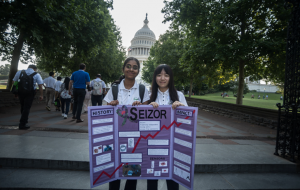 Created by 11th graders Krishnapriya Nagasubramanian and Cynthia Li from Victoria Park Collegiate Institute in Ontario Canada. Supported by Coach Stacy Batras and Mentor Sarah Torrie.
Created by 11th graders Krishnapriya Nagasubramanian and Cynthia Li from Victoria Park Collegiate Institute in Ontario Canada. Supported by Coach Stacy Batras and Mentor Sarah Torrie.
Seizor is a device that aims to reduce and forecast seizures and provide automatic treatment for those suffering from seizures, so that they can experience a greater quality of life and reduced stress in their daily lives. It uses an AI feature and new technology such as vagus nerve stimulation.
Second-Place Winners:
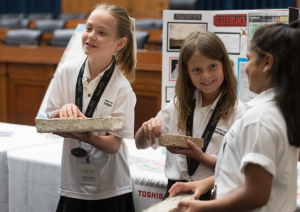 Created by 3rd graders Sofia Taha, Kason Sonnenberg-Trent, and Charlie Pilgrim, from Don Campbell Elementary School in Alberta, Canada. Supported by Coach Melina Powell and Mentor Rabia Taha.
Created by 3rd graders Sofia Taha, Kason Sonnenberg-Trent, and Charlie Pilgrim, from Don Campbell Elementary School in Alberta, Canada. Supported by Coach Melina Powell and Mentor Rabia Taha.
BlazeBlock is a building material designed to protect homes from fires by actively suppressing flames. With the eco-friendly benefits of HempBlock, BlazeBlock integrates fire-activated microcapsules, smart thermal sensors, and bio-engineered mycelium to detect and combat fires in real-time. The microcapsules release fire-retardant gel when exposed to heat, while the sensors trigger an alert to fire response systems. Additionally, the mycelium network releases natural fire-retardant compounds, providing a self-extinguishing feature. BlazeBlock is set to redefine fire safety in homes, combining sustainability with innovative fire-fighting capabilities.
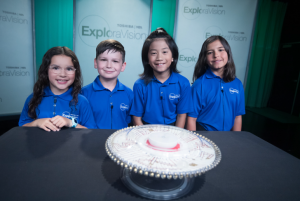 Created by Gustavo Lopez (4th grade), Uriah Molly (4th grade), Teddy Thomas (2nd grade), and Mari Truong (2nd grade) from Heritage School in Salem, Oregon. Supported by Coach Maureen Foelkl.
Created by Gustavo Lopez (4th grade), Uriah Molly (4th grade), Teddy Thomas (2nd grade), and Mari Truong (2nd grade) from Heritage School in Salem, Oregon. Supported by Coach Maureen Foelkl.
Dementia is a serious illness that impairs a person’s ability to think and remember. Lost Then Found is an innovative micro-patch worn between the shoulder blades, tracking the user’s location in real-time using quantum technology. A quantum accelerometer measures movement, while body heat powers the patch. It securely attaches with micro-suckers, and caregivers use a sharing app to monitor the wearer’s location. Lost Then Found offers peace of mind by quickly locating loved ones who are battling dementia.
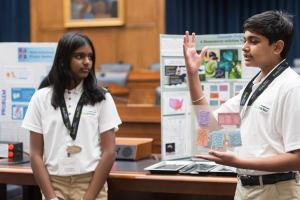 Created by 7th graders Anirudh Rao and Aarna Varre from STEM School Highlands Ranch in Colorado. Supported by Coach Sheetal Rajput and Mentor Bharathi Rao.
Created by 7th graders Anirudh Rao and Aarna Varre from STEM School Highlands Ranch in Colorado. Supported by Coach Sheetal Rajput and Mentor Bharathi Rao.
The goal of the Biomimetic Surfaces is to address the problem of icy roads by introducing a novel approach based on the properties perfected by nature over millions of years of evolution. Using biomimicry and hydrophobic properties of flora/fauna, this team found a unique way to improve the design of road surfaces to reduce icy conditions, increase friction, and improve vehicle stability. This design can be stamped into concrete or used in materials pre-formed with the pattern, making it ideal for roads and other surfaces where ice formation is undesirable. The solution can be customized for various applications to prevent ice buildup.
Nano Artertract Plaque Seeker (NAPS):
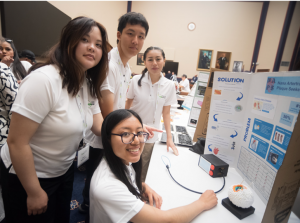 Created by Ziyang Deng (10th grade), Hannah Romero (10th grade), Lerou Li (11th grade), and Shelley Ajin (12th grade) from Downtown Magnets High School in Los Angeles, California. Supported by Coach Vy Le.
Created by Ziyang Deng (10th grade), Hannah Romero (10th grade), Lerou Li (11th grade), and Shelley Ajin (12th grade) from Downtown Magnets High School in Los Angeles, California. Supported by Coach Vy Le.
NAPS (Nano Artertract Plaque Seeker) is a non-invasive treatment for coronary artery disease designed to target and reduce arterial plaque buildup. NAPS utilizes iron oxide nanoparticles and magnetic guidance to ensure precise drug delivery. It is powered by rapamycin and necrostatin-1 as the main drugs to address inflammation and reduce plaque accumulation.
A Trip to D.C. with the 2025 ExploraVision National Winners:
During their trip to D.C., the national winners attended a Welcome Science Fair and Medal Presentation at Capitol Hill where they received a tour and had the chance to visit the offices of Representatives and Senators.
The students also had the chance to explore the historic National Press Club where they were interviewed by prominent media members from national and local news channels to discuss their winning projects, the inspiration behind them and their experience participating in the ExploraVision process.
The trip concluded with an awards luncheon to honor the finalists and their accomplishments. The Mayor of Washington D.C. has sent a Proclamation that June 13th as ExploraVision day. Students heard from special guest speakers including Bill Nye The Science Guy, U.S. and Japanese officials, like Mr. Kosei Nomura, Minister, Embassy of Japan and Dr. Nancy Kamei, Chief Public Engagement Officer of the US Patent, and Toshiba executives including Mr. Tom Kumagai, Chairman & CEO of TAI and President of TAEC.
Congratulations to the 2025 national winners! Register now to receive updates about ExploraVision 2026!”
